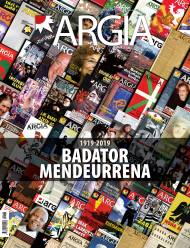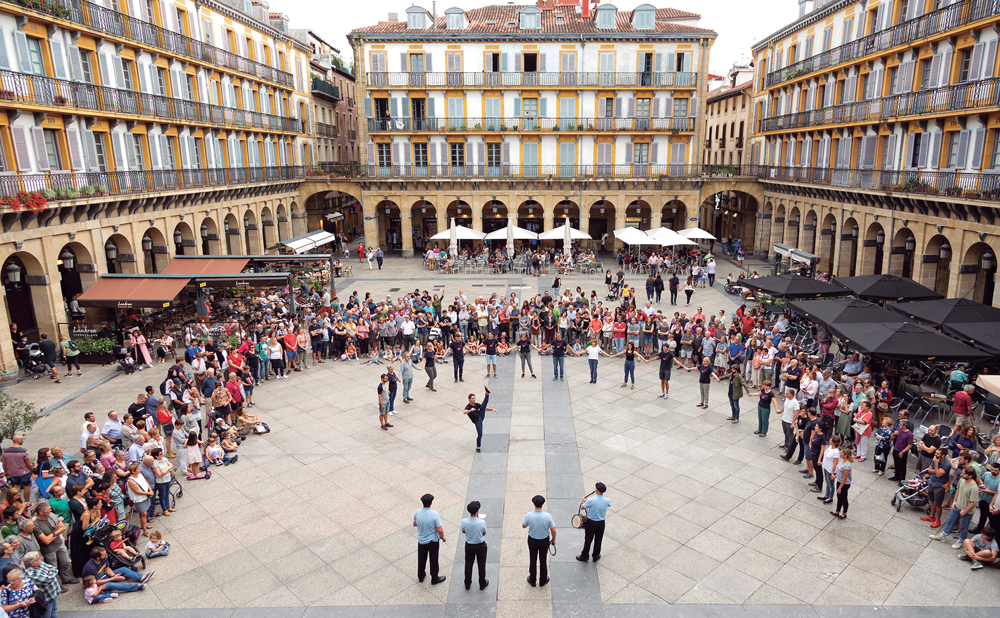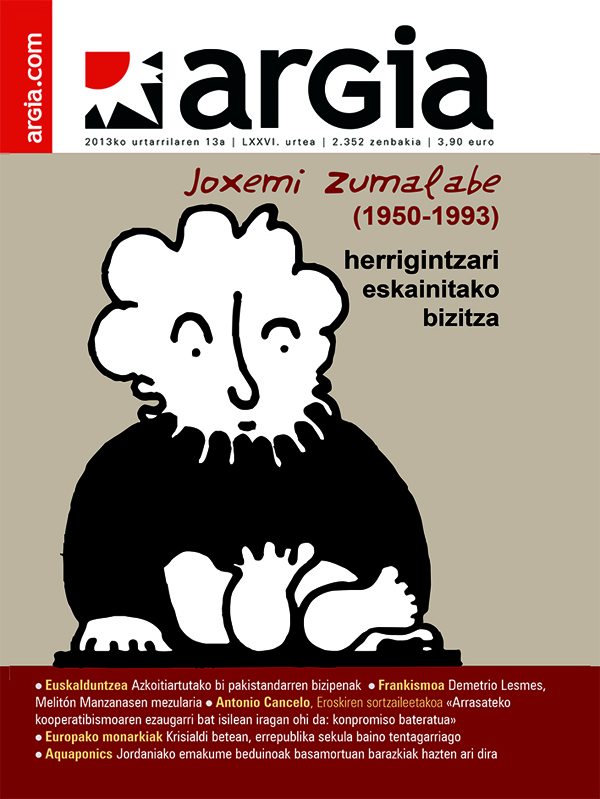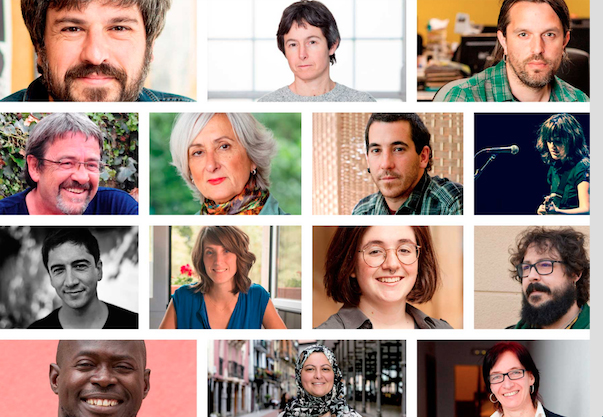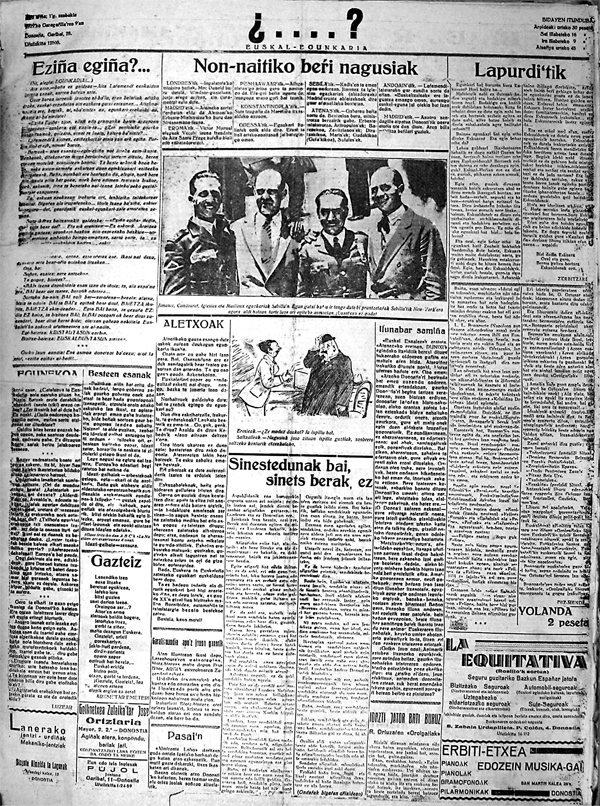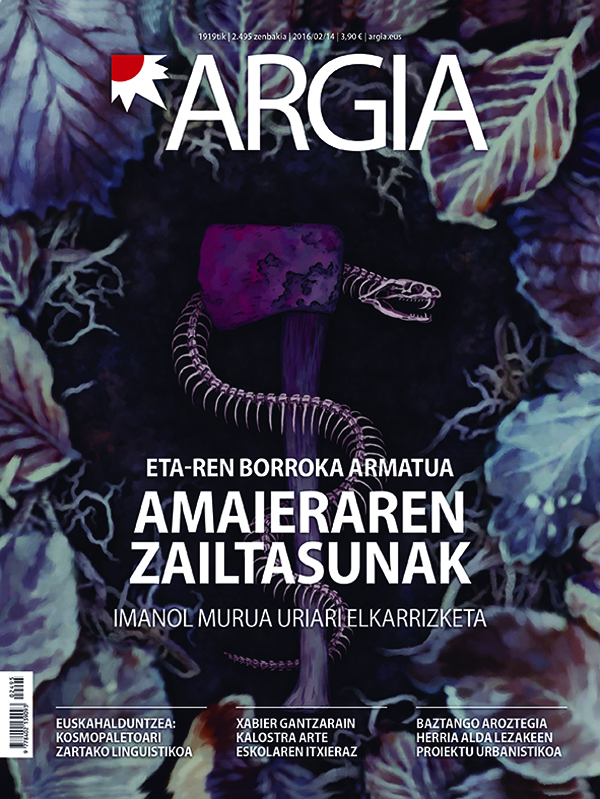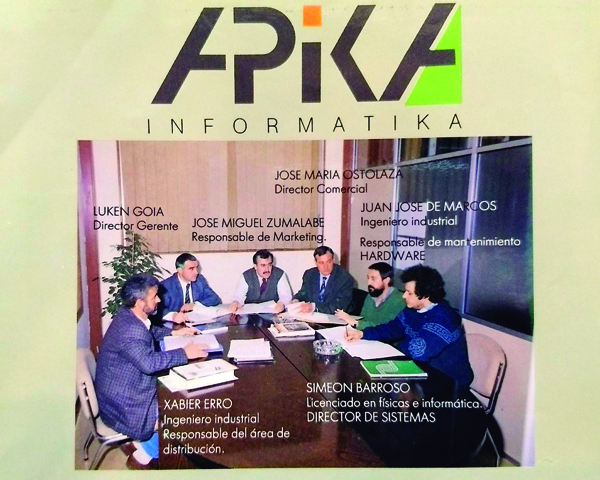The heritage of all, in the hands of all
- ARGIA will be 100 years old in 2019. During all these years, the Dean journalist in Euskera has been the link between many cultures, writers and journalists. It is therefore a year in which not only the centenary of a media but the entire evolution of the Basque press is celebrated and recognised. ARGIA will make available to the citizens the heritage created in this tour: a project has been launched to digitize all its numbers and the historical photographic archive.
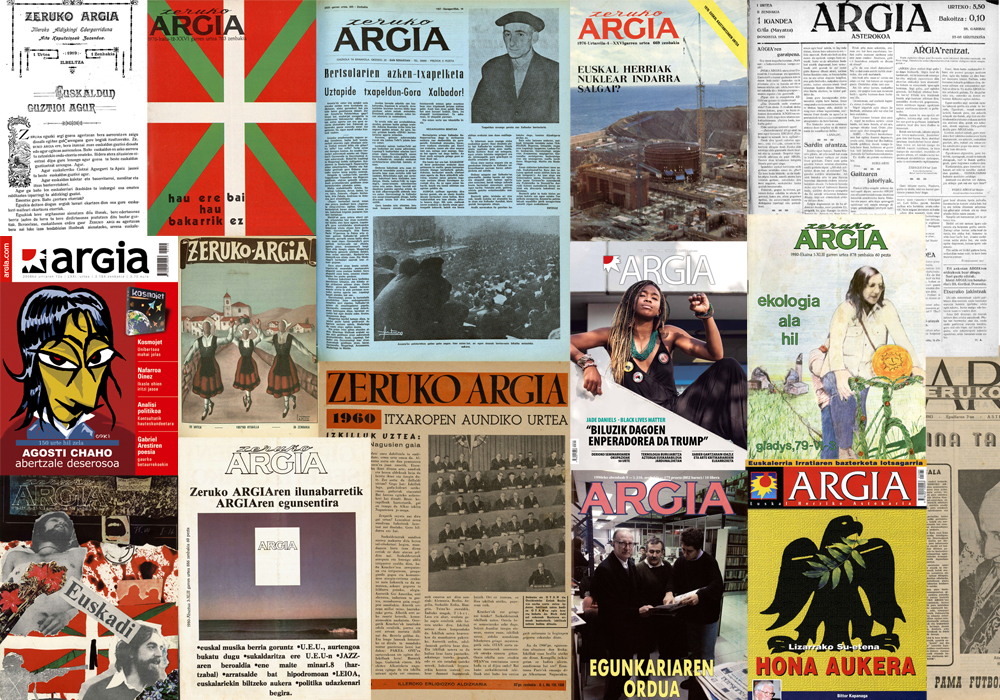
ARGIA lost four out of five advertising clients, had large debts and many journalists turned to the new media that prioritized Spanish. And yet, I was alive. This scene at the end of the 1970s would also serve to describe a journey of a hundred years, which is, above all, a history of survival. To get out of that impasse in the late 1970s, they created a cooperative at the initiative of Joxe Mari Ostolaza and Joxemi Zumalabe, and so, again, thanks to the mattress on which it was based, it was possible to land: the militancy and the support of the people.
ARGIA is alive, and that is the only reason why the centenary is celebrated; a programme full of initiatives is being organised in this house. But there's more reason to blow the candles.
The journalist has played an important role in the development of modern Basque journalism, especially since he became the general weekly of Argia in the pre-war period and in 1963 he dedicated himself to political and social issues, “at the time when there was nothing, he created new writers and journalists,” said the then responsible Agustin Ezeiza, and has been a pioneer in many ways: both in Franco daily and in the promotion of Ikastolas and singh.

“We have completed a hundred years, the last 30 years thanks to the support of the companies of the Ametzagaiña group – we explained the members of ARGIA in the centenary presentation in Donostia. But we want to fulfill another hundred, and to do so we need the support of Argia people and the commitment of public institutions.” The presentation was attended by Estibalitz Alkorta, Director of Promotion of the Basque Government. In his opinion, we must recognize the strategic value of the media in Euskera, and in this sense, he said that they are "indebted" to ARGIA.
The Department of Culture of the Basque Government has collaborated with the Department of Culture of the Basque Government on the occasion of the centenary. Thanks to this you will be able to undertake an ancestral desire or intention: to digitize all the numbers and the historical photographic archive. ARGIA will make a 100-year heritage available to the public.
.jpg)
Digitisation project: what, how and for what
With this in your hands, ARGIA has published 2,624 numbers throughout the century. Not continuously, the post-war repression forced him to undergo a long interruption between 1936 and 1954, and between that year and 1963 he suffered many vicissitudes. From there, despite the fact that in the 1960s and 1970s censorship was suffocating – it was sanctioned for proclaiming an independent university or for putting ikurrina on the skin under the direction of Mikel Atxaga – and despite the fact that in the 1980s it has often been relegated to public aid, it has come home every week.
The contents of the last twelve years Argia.eus are freely available on the web, and the numbers of Argia in San Sebastian, from its creation in 1921 until its disappearance in 1936, are also in pdf format, among others in the portal Armiarma de Susa. Everything else is contained in libraries or libraries' reserved funds, condemned to be in bound volumes or in particular collections.
We are talking about a capital of 80,000 pages that emerged on this long journey, which offers information from the time, entirely in Basque and from the Basque country. It is a question of digitizing and making available to all this heritage, so that the reader can freely and free access to articles and reports, carry out concrete searches in the text and, in particular, expand and share its content as much as possible. This idea coincides with the liberal Creative Commons philosophy defended by ARGIA. Does production in Basque need no live readers?

Digitisation shall be carried out using the OCR system. It's a process that knows optical characters: it passes the scanner to a written page and turns the text of that simple image into editable. Previously, there were studies of digitization of ARGIA numbers, but the result was low. However, in recent years, OCR technology has evolved a lot and it will now be possible to quickly access a better quality text of images from old pages with a lot of irregular typography and gray range. The next challenge would be to integrate this text into the web Argia.eus as the current content is.
Photographic archive: 40,000 mirrors of our history
ARGIA also intends to digitize and publish its historical photographic archive, animated by the centenary. These are thousands of images that reflect our recent history, a treasure that this media carries with it every time it has changed its headquarters.
The photographic archive collects images from the 1970s and 1980s mainly, and constitutes a relevant graphic material of the social and political events of the time – as can be seen in the exhibition Transitions, curated in 2015. As for Basque cultural activity, for example, they are very valuable because of their subject and perhaps because they are the only ones; in the 1980s ARGIA was one of the few journalists that worked.
Before we start digitizing the photographs, we've started cataloguing them. The material is stored in folders and envelopes and consists of two backgrounds. On the one hand there is the classified part with the names and surnames of the people – especially those of the interviews – which are photographs of over 4,000 characters who have left their mark on Basque culture or politics. The other fund is classified by themes and photographs can be found of the first festivals of the ikastolas, of the encierros of the workers or of the demonstrations repressed by the police.

As explained in the centenary presentation, “we still don’t know how many photos we have.” So far 15,600 photographs have been cataloged, but given the size of the file, it is estimated that they could be 40,000. Although many of them are of unknown origin, one of the objectives of this initial work is to define the context, year and authorship of photography with the available data. Then, once the photos were digitalized and the reusability was guaranteed, they would be hung on the ARGIA website.
Year 2019, year of celebration
To celebrate the hundred years, next year ARGIA will organize round tables and other cultural events of a monthly and territorial nature. In addition, the main annual appointments will also focus on the centenary, such as the Argia Awards, which this year are given in Bilbao. The 30th edition of the awards, which have become a reference in the field of communication in Basque, will continue to be the meeting point of the sector as in its beginnings, but this year the people and agents who have participated in ARGIA will have a great prominence.
ARGIA starts the year with strength, giving away its readers: The first number of 2019 will be special in terms of figure, appearance and length. With a nod to the centenary, he will publish a 100-page weekly, with extensive reports and interviews, and a special section in which he will review the role of the Dean journalist in the history of journalism in Euskera.
On the other hand, in all the issues of next year, the fixed space dedicated to the centenary, written by journalist Miren Osa, will be a weekly ounce to get to know the curiosities, ephemeris and the intrahistory of this medium. In addition, each issue will be accompanied by a facsimile of one of the historical covers of the weekly, illustrated with a text by the writer Koldo Izagirre.

He was born in the 20th century, but he wants to keep doing the journalism of the future, of another kind, transformative. Based on the moments that have marked the development of this journalism model in recent decades, ARGIA will publish a essay book in the autumn.
Transformer and independent. It is a communication project that does not support slavery or servitude, and to that end the key is the community. Gerraurre-Argia sent “negligible” young sellers to distribute the weekly in the vicinity of the villages; in 1963, when they repopulated it, the commissioners paid for the weekly also went from town to village, both north and south. And today, ARGIA has a new affiliation system in place. Give what you can and what you want to receive is your call for people to financially support the project.
People are the body and language is the heart. From that 1919 Celestial Light, religious “Embellecedora Journal,” to the present transforming and independent media, there are not only a hundred years away, but there is also a great difference of flesh and bone. But the navel among them bears the same blood: the Basque.
2019 has been a special year for ARGIA, an example of this is this number that you have in your hands. Turning a hundred years is not an easy achievement, even more so for a small media outlet in Basque. The celebrations have taken different forms throughout this year and, as... [+]
On the day of the presentation of book 111 Hostoz eta Orriz we had the opportunity to learn about the culture of Duzunaritz. A delicious day to round off a series of celebrations that fill the century of Argia. I can't imagine a more beautiful path than to dirty the shoes in... [+]









